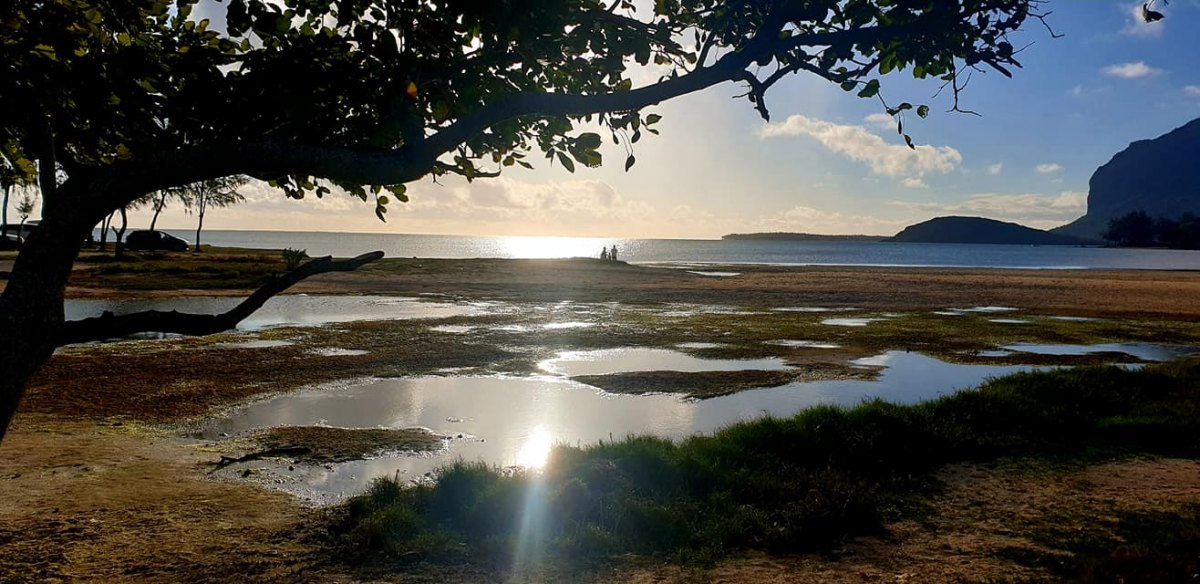
Panorama of La Prairie & tide puddles on the beach

My favorite place to relax and connect with nature. At low tide, you can see the sea in the distance. Only a few morning walkers animate this so calm scenery. To dip your feet, you will have to cross this lifeless expanse of rocks and sand. Lifeless? Not so sure... Let's take a closer look... This tidal zone (or intertidal zone), between land and sea, submerged and then emerged twice a day, is populated with marine animals and plants. Marine? Yes, they can normally only breathe and live in water. Of course, those that are very low on the beach stay out of the water for a short time at low tide, but those that live at the top of the beach spend most of the time emerged! How do they resist the lack of oxygen and nutrients (normally provided by water), desiccation, sunlight and heat of a summer afternoon? Most of them are cunning and will find humid places sheltered under rocks, under algae or in puddles, those pools of water in the rocks that the sea leaves when it withdraws. However, crustaceans such as crabs are found outside these pools. However, they breathe by gills and not by lungs! How do they manage to breathe out of the water? The green crab (Carcinus maenas) keeps a bottom of water in its gill cavities. Even if the body of the animal is out of the water, its gills, under the carapace, are still immersed and functional. With appendages located around its mouth (the maxillae), it creates a current of water which still facilitates its breathing. And the little wrigglers scattered on the beach? They signal the presence of an annelid: the arenicola (Arenicola marina). This worm filters the sand and feeds on the microscopic animals and plants found there. Everything it does not ingest is thrown away in the form of a sandy twist. At low tide, the arenicole remains in its humid tunnel and returns to a slow life until the sea rises. The animal stops feeding, its gills retract and its circulatory system almost stops. And these small dark red slimy balls that we see in the basins or in the crevices of the rocks ? Animal or vegetable? It is a sea anemone, Actinia equinia, which belongs to the same group of animals as corals or jellyfish: the cnidarians. Sea anemones look like bags with only one opening. They filter the water to feed themselves. As a flower spreads its petals, they spread, under water, around their orifice, many tentacles often very colored and especially stinging. At low tide, no more question of being beautiful! The sea anemone pulls in all its tentacles and curls up waiting for the water to come back. In any case, to protect itself from hostile living conditions, there's nothing like sealing itself up tight! Happy, therefore, the gastropod molluscs which can take refuge in their shells with a little sea water! Thus the periwinkle (Littorina littorae), enters its body in its shell and -clac !- closes this one with its calcareous operculum which is used as door. A little higher on the beach, one distinguishes hardly the limpet (Patella vulgata) from the rock on which it is stuck. At high tide, like its cousin the periwinkle, the limpet moves and grazes on the microscopic algae on the surface of the rocks. But as soon as the sea recedes, it quickly returns to its favorite place. Indeed, with time the limpet sticks so much to the rock that it digs there a place adapted to the size and the shape of its shell. There, adhering perfectly to the surface of the rock, the limpet can resist to the desiccation during two times six hours a day, even during the summer!
We have 74 guests and no members online